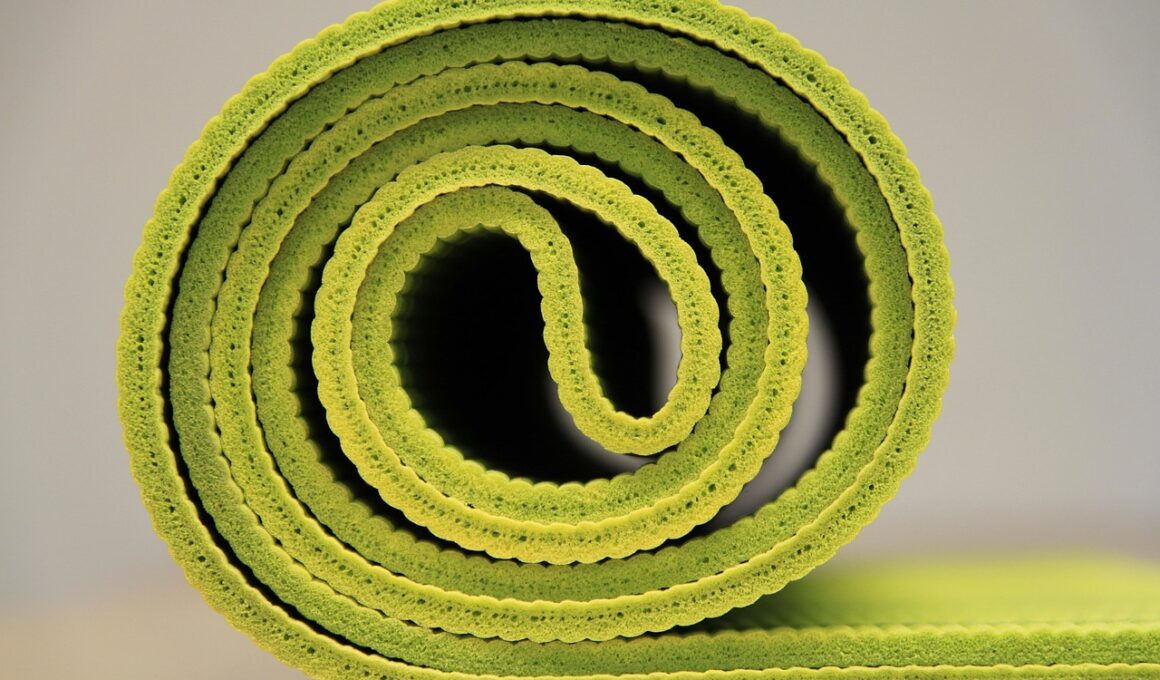Beginner’s Guide to Yoga Mats: What to Look For
Yoga is a wonderful practice known to enhance both physical and mental wellbeing. When embarking on your yoga journey, choosing the right equipment is essential, with the yoga mat being the most significant piece. Not all yoga mats are created equal, so it’s wise to understand the features that matter most. Factors such as thickness, material, and texture can significantly influence your comfort and performance during practice. For beginners, a good yoga mat provides stability and support, ensuring you can hold poses correctly without slipping. Additionally, consider the mat’s portability if you plan to join classes outside your home. A lightweight and foldable mat is ideal for on-the-go yogis. Before purchasing, it may be beneficial to test several mats to find one that meets your needs. Reviews from other yogis can also offer valuable insights. Make sure to invest in a quality mat, as it can make a substantial difference in your yoga experience. In this guide, we will explore the various types of yoga mats and their unique characteristics.
The next key factor to consider is the thickness of your yoga mat, which plays a pivotal role in the comfort during your practice. Typically, yoga mats come in varying thicknesses: standard mats measure approximately 1/8 inch, while extra-thick mats are about 1/4 inch. Each option serves different users according to their preference and practice style. Beginners may appreciate thicker mats, as they provide added cushioning and support for sensitive joints like knees and elbows. Thinner mats, on the other hand, offer better connection with the ground, essential for balance poses eventually. Choosing the right thickness also depends on the type of yoga you intend to practice. For instance, if you enjoy more vigorous styles like Ashtanga or Power Yoga, a thinner mat may suit you better for stability during challenging poses. Additionally, consider how easy it will be to transport your chosen mat, as thicker mats tend to weigh more. Assessing your personal factors will help determine the ideal mat thickness for your yoga sessions.
Material Matters
The material of your yoga mat is another critical element that influences both performance and longevity. Various materials are used to manufacture yoga mats, including PVC, TPE, natural rubber, and jute. PVC mats are common due to their affordability and durability; however, they are not the most eco-friendly option. If sustainability is a concern for you, consider eco-friendly materials such as TPE or natural rubber. TPE is biodegradable and free from harmful chemicals, making it a safer choice for those environmentally conscious. Natural rubber mats, known for their grip, are excellent for hot yoga sessions as they tend to perform better in humid conditions. Additionally, they provide good cushioning, which is beneficial for your joints. Jute mats offer a unique texture and are biodegradable, but they may not give the same stability and grip as rubber mats. Ultimately, test different materials before making a decision, as personal comfort and grip are paramount for a successful practice.
The texture of your yoga mat impacts your grip, which is vital for maintaining stability in poses. A mat with a textured surface can offer enhanced grip that helps you stay secure in various positions. Many mats feature raised patterns or surface textures designed to provide traction, especially during sweaty workouts. When selecting a yoga mat, practicing on it before purchasing is advisable. This step ensures that the texture meets your personal comfort level and grip requirements. For hot yoga or more intense practices like Vinyasa, look for mats specifically designed to enhance grip in sweaty conditions. Conversely, softer textures may appeal to those performing gentle stretches and restorative practices. Ensuring that your mat feels comfortable underfoot will help you focus on your flow without distraction. Additionally, the wear and tear of your mat’s texture can indicate its lifespan. Regularly checking for degradation allows you to replace your mat while maintaining safety and performance in your practice.
Maintenance and Care
Maintaining your yoga mat properly is essential for its longevity and performance. A clean mat not only looks attractive, but it also minimizes the risk of slipping and maintains grip. To preserve your mat, it’s wise to clean it regularly. This can typically be accomplished with mild soap and warm water, using a soft cloth or sponge. Be cautious of using abrasive materials that may damage the texture of the mat. Depending on the material, you might be able to machine wash your mat, but always refer to the manufacturer’s instructions. Properly air drying your mat after cleaning is critical, as excessive heat can warp materials, especially those made from rubber. Additionally, always store your mat in a dry area away from direct sunlight, as UV rays can degrade materials over time. Developing a routine for mat maintenance ensures its functionality doesn’t diminish, allowing for a worry-free practice. Moreover, a well-maintained mat can enrich your overall experience and investment in the art of yoga.
When selecting a yoga mat, budget is always a consideration. While it may be tempting to opt for the cheapest option, it’s essential to recognize that quality usually correlates with price. Lower-priced mats may sacrifice durability and grip, leading you to replace them often. On the other hand, investing in a quality mat may seem costly initially, yet it can save you money over time by lasting longer and performing better. Look for mats within your budget that provide the features you deem necessary, but don’t settle for subpar options just to save a few dollars. An affordable mid-range mat may offer the best balance of quality and price. Thoroughly researching and comparing options is beneficial; consider online reviews for additional insights into durability and performance from actual users. Ultimately, consider purchasing from reputable brands that offer warranties or guarantees, as they usually stand behind their products. This precaution can provide peace of mind knowing that your investment is protected.
Conclusion and Recommendations
In summary, selecting the right yoga mat is an integral part of enhancing your yoga practice. Prioritize factors such as thickness, material, texture, maintenance, and a suitable budget when making your decision. By understanding your unique needs and practicing on several mats, you can identify the perfect fit for your yoga journey. Don’t hesitate to invest wisely in a quality mat, as it can significantly enhance your comfort, stability, and performance in yoga. Remember to maintain your chosen mat for optimal longevity and continued enjoyment throughout your practice. Consider asking knowledgeable staff at specialized retailers for guidance tailored to your specific requirements. By equipping yourself with adequate information, you’re setting the stage to enjoy long-lasting and fulfilling yoga sessions. Lastly, consistently practicing on your chosen mat will help you develop your skills and connection through yoga. Embracing the process of finding the ideal mat is a vital step towards achieving both physical and mental wellness.
Happy yoga mat shopping, and best of luck as you delve into the transformative world of yoga! Don’t forget the journey is just as important as the destination, and each session will help you grow. Focus on your breathing, exploration of poses, and most importantly, enjoy. Namaste!


